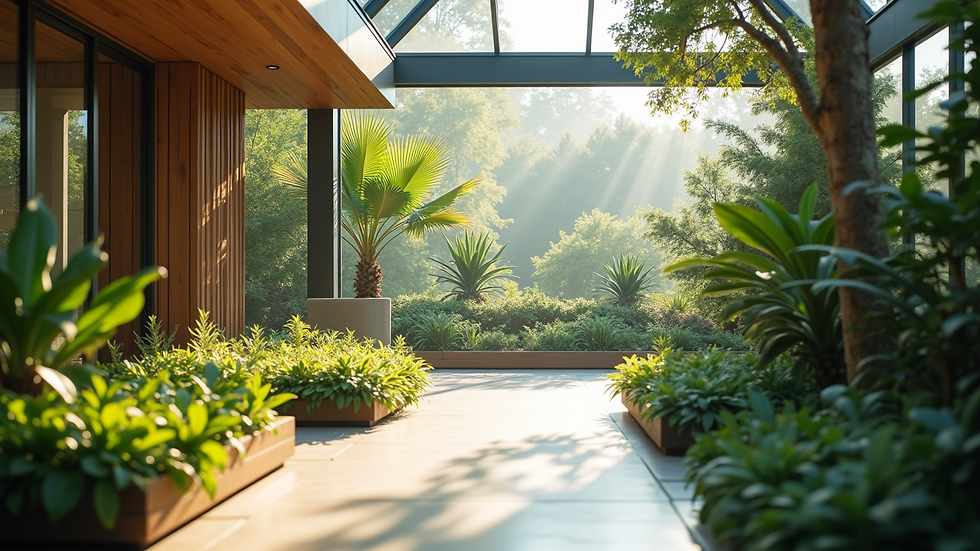Exploring the Connection Between Biophilic Design and Sick Building Syndrome for Healthier Spaces
- Yash Joshi
- May 4
- 4 min read
Biophilic design has become essential in creating healthier, more inspiring environments. By integrating nature into our indoor spaces, we promote well-being, productivity, and sustainability. However, many indoor environments suffer from a challenge known as Sick Building Syndrome (SBS). This condition affects individuals who experience health issues linked to prolonged time spent inside specific buildings. In this post, we will explore how biophilic design can serve as a solution to mitigate the effects of Sick Building Syndrome, leading to healthier spaces for all occupants.
Understanding Sick Building Syndrome
Sick Building Syndrome includes various health issues related to poor indoor air quality. Common symptoms are headaches, skin irritation, respiratory difficulties, and fatigue. For example, a study by the World Health Organization found that more than 30% of new or renovated buildings worldwide have substantial indoor air quality problems.
Several factors can make a building "sick." Moisture problems, inadequate ventilation, and insufficient natural light often contribute to a negative indoor environment. For instance, buildings without adequate airflow can result in high levels of indoor pollutants, leading to significant health concerns. Understanding the root causes of these issues is crucial for implementing effective solutions.
What is Biophilic Design?
Biophilic design focuses on re-establishing people's connection to nature through thoughtful architectural elements. This principle is based on the idea that humans have an innate bond with nature, and bringing natural elements into our spaces promotes both mental and physical well-being. Examples of biophilic design include:
Indoor Plants: Incorporating greenery into spaces, which can help improve air quality and aesthetics.
Natural Lighting: Utilizing large windows and skylights to maximize daylight.
Such designs aim not only to fulfill functional needs but also to enhance the health and happiness of occupants.
The Role of Biophilic Design in Mitigating SBS
Improved Air Quality
Biophilic design significantly enhances indoor air quality. Plants are a key element, as they absorb pollutants and release oxygen. According to studies, having plants indoors can reduce airborne dust by 20% and volatile organic compounds (VOCs) by up to 50%.
Implementing features like green walls or living roofs contributes greatly to overall air quality. This is particularly beneficial for individuals susceptible to allergies or respiratory issues, making the indoor environment feel fresher and more inviting.
Enhanced Natural Light
Natural light is vital for mental and physical health. Studies indicate that exposure to natural lighting can improve mood and productivity by 15%. Biophilic design enhances natural light through the integration of large windows and skylights, which also helps regulate circadian rhythms—critical for quality sleep and overall wellness.
Ensuring residents have access to ample natural light can substantially mitigate symptoms associated with Sick Building Syndrome. Improved lighting can result in fewer cases of depression and anxiety among occupants, ultimately contributing to a much healthier living space.
Connection to Nature
Creating visual connections with nature is key to biophilic design. This can involve views of trees, gardens, or water features. Research shows that even brief visual exposure to nature can reduce stress levels by up to 37%.
In urban settings, where access to green spaces might be limited, enhancing visual connections to nature through thoughtful design can provide significant psychological benefits, helping individuals feel more relaxed and at ease in their environments.

Practical Biophilic Design Strategies
Integrating Natural Materials
Utilizing natural materials like wood, stone, and clay in construction and design helps create an organic look and feel. For example, a recent hotel designed with reclaimed wood and natural stone not only looks beautiful but also promotes a comforting atmosphere. Such textures make spaces feel more inviting, reducing stress and discomfort often caused by Sick Building Syndrome.
Incorporating Water Elements
Water features such as fountains or aquariums can greatly enhance a space. The soothing sound of flowing water can create a calming environment, further connecting occupants to nature. A report from the University of Exeter found that spaces with water features can make individuals feel 30% calmer than those without.
These elements not only beautify spaces but also foster a sense of tranquility, crucial for improving residents' overall well-being.
Creating Green Spaces
Incorporating green areas, whether indoor gardens or outdoor terraces, encourages occupants to connect with their environment. Research highlights that access to green spaces can reduce symptoms of anxiety and depression by 25%. These areas can become relaxing spots for socializing or simply unwinding, promoting a sense of community among residents.
Green spaces can serve as a counterbalance to daily stress, further lowering the likelihood of experiencing Sick Building Syndrome.

The Importance of Biophilic Design for Healthier Spaces
The relationship between biophilic design and Sick Building Syndrome emphasizes the importance of human health in the construction of indoor environments. By integrating natural elements and improving indoor quality, biophilic design offers effective solutions to lessen the symptoms associated with SBS.
Focusing on designs that prioritize well-being should be a key goal for all building projects. By advocating for such approaches, we enhance daily experiences and foster a sustainable connection with the spaces we inhabit. As our understanding of biophilic design continues to grow, it becomes clear that this approach is not just a passing trend; it is essential for promoting healthier living.


Comments